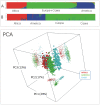Investigating the role of mitochondrial haplogroups in genetic predisposition to meningococcal disease
- PMID: 20019817
- PMCID: PMC2790606
- DOI: 10.1371/journal.pone.0008347
Investigating the role of mitochondrial haplogroups in genetic predisposition to meningococcal disease
Abstract
Background and aims: Meningococcal disease remains one of the most important infectious causes of death in industrialized countries. The highly diverse clinical presentation and prognosis of Neisseria meningitidis infections are the result of complex host genetics and environmental interactions. We investigated whether mitochondrial genetic background contributes to meningococcal disease (MD) susceptibility.
Methodology/principal findings: Prospective controlled study was performed through a national research network on MD that includes 41 Spanish hospitals. Cases were 307 paediatric patients with confirmed MD, representing the largest series of MD patients analysed to date. Two independent sets of ethnicity-matched control samples (CG1 [N = 917]), and CG2 [N = 616]) were used for comparison. Cases and controls underwent mtDNA haplotyping of a selected set of 25 mtDNA SNPs (mtSNPs), some of them defining major European branches of the mtDNA phylogeny. In addition, 34 ancestry informative markers (AIMs) were genotyped in cases and CG2 in order to monitor potential hidden population stratification. Samples of known African, Native American and European ancestry (N = 711) were used as classification sets for the determination of ancestral membership of our MD patients. A total of 39 individuals were eliminated from the main statistical analyses (including fourteen gypsies) on the basis of either non-Spanish self-reported ancestry or the results of AIMs indicating a European membership lower than 95%. Association analysis of the remaining 268 cases against CG1 suggested an overrepresentation of the synonym mtSNP G11719A variant (Pearson's chi-square test; adjusted P-value = 0.0188; OR [95% CI] = 1.63 [1.22-2.18]). When cases were compared with CG2, the positive association could not be replicated. No positive association has been observed between haplogroup (hg) status of cases and CG1/CG2 and hg status of cases and several clinical variants.
Conclusions: We did not find evidence of association between mtSNPs and mtDNA hgs with MD after carefully monitoring the confounding effect of population sub-structure. MtDNA variability is particularly stratified in human populations owing to its low effective population size in comparison with autosomal markers and therefore, special care should be taken in the interpretation of seeming signals of positive associations in mtDNA case-control association studies.
Conflict of interest statement
Figures

Similar articles
-
No evidence that major mtDNA European haplogroups confer risk to schizophrenia.Am J Med Genet B Neuropsychiatr Genet. 2012 Jun;159B(4):414-21. doi: 10.1002/ajmg.b.32044. Epub 2012 Mar 29. Am J Med Genet B Neuropsychiatr Genet. 2012. PMID: 22467472
-
No evidence of association between common European mitochondrial DNA variants in Alzheimer, Parkinson, and migraine in the Spanish population.Am J Med Genet B Neuropsychiatr Genet. 2015 Jan;168B(1):54-65. doi: 10.1002/ajmg.b.32276. Epub 2014 Oct 28. Am J Med Genet B Neuropsychiatr Genet. 2015. PMID: 25349034
-
Characterization of mitochondrial haplogroups in a large population-based sample from the United States.Hum Genet. 2014 Jul;133(7):861-8. doi: 10.1007/s00439-014-1421-9. Epub 2014 Feb 1. Hum Genet. 2014. PMID: 24488180 Free PMC article.
-
Association between mitochondrial DNA haplogroup and myelodysplastic syndromes.Genes Chromosomes Cancer. 2016 Sep;55(9):688-93. doi: 10.1002/gcc.22370. Epub 2016 Jun 21. Genes Chromosomes Cancer. 2016. PMID: 27121678 Free PMC article.
-
Mitochondrial genetics and osteoarthritis.Front Biosci (Schol Ed). 2013 Jan 1;5(1):360-8. doi: 10.2741/s377. Front Biosci (Schol Ed). 2013. PMID: 23277056 Review.
Cited by
-
Whole Exome Sequencing Identifies New Host Genomic Susceptibility Factors in Empyema Caused by Streptococcus pneumoniae in Children: A Pilot Study.Genes (Basel). 2018 May 3;9(5):240. doi: 10.3390/genes9050240. Genes (Basel). 2018. PMID: 29751582 Free PMC article.
-
Mitochondrial DNA ancestry, HPV infection and the risk of cervical cancer in a multiethnic population of northeastern Argentina.PLoS One. 2018 Jan 12;13(1):e0190966. doi: 10.1371/journal.pone.0190966. eCollection 2018. PLoS One. 2018. PMID: 29329337 Free PMC article.
-
Breast cancer risk and genetic ancestry: a case-control study in Uruguay.BMC Womens Health. 2015;15:11. doi: 10.1186/s12905-015-0171-8. Epub 2015 Feb 18. BMC Womens Health. 2015. PMID: 25783644 Free PMC article.
-
'Infertile' studies on mitochondrial DNA variation in asthenozoospermic Tunisian men.Biochem Biophys Rep. 2016 Aug 11;8:114-119. doi: 10.1016/j.bbrep.2016.08.002. eCollection 2016 Dec. Biochem Biophys Rep. 2016. PMID: 28955946 Free PMC article.
-
Meta-Analysis of Mitochondrial DNA Variation in the Iberian Peninsula.PLoS One. 2016 Jul 21;11(7):e0159735. doi: 10.1371/journal.pone.0159735. eCollection 2016. PLoS One. 2016. PMID: 27441366 Free PMC article.
References
-
- Kirsch EA, Barton RP, Kitchen L, Giroir BP. Pathophysiology, treatment and outcome of meningococcemia: a review and recent experience. Pediatr Infect Dis J. 1996;15:967–978; quiz. - PubMed
-
- Lo H, Tang CM, Exley RM. Mechanisms of avoidance of host immunity by Neisseria meningitidis and its effect on vaccine development. Lancet Infect Dis. 2009;9:418–427. - PubMed
-
- Emonts M, Hazelzet JA, de Groot R, Hermans PW. Host genetic determinants of Neisseria meningitidis infections. Lancet Infect Dis. 2003;3:565–577. - PubMed
-
- Brouwer MC, de Gans J, Heckenberg SG, Zwinderman AH, van der Poll T, et al. Host genetic susceptibility to pneumococcal and meningococcal disease: a systematic review and meta-analysis. Lancet Infect Dis. 2009;9:31–44. - PubMed
Publication types
MeSH terms
Substances
LinkOut - more resources
Full Text Sources
Medical

